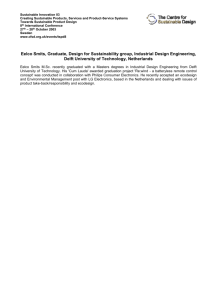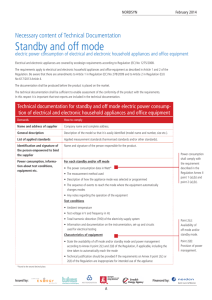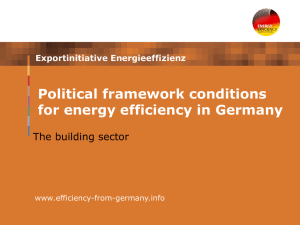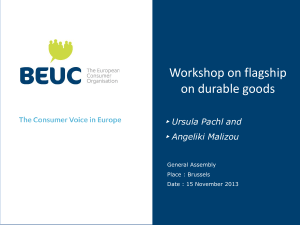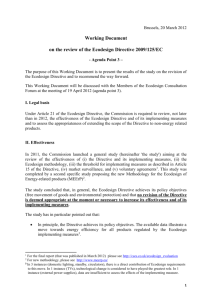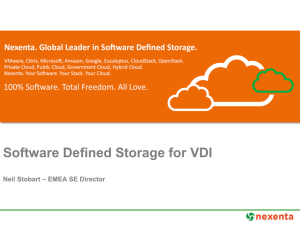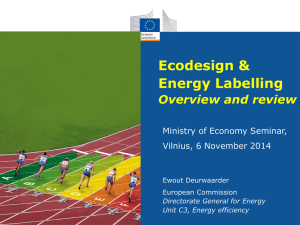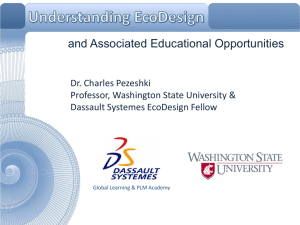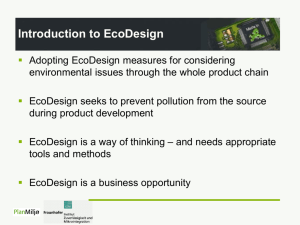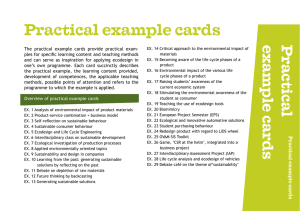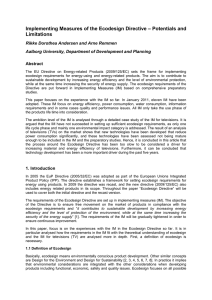sustainable product design
advertisement
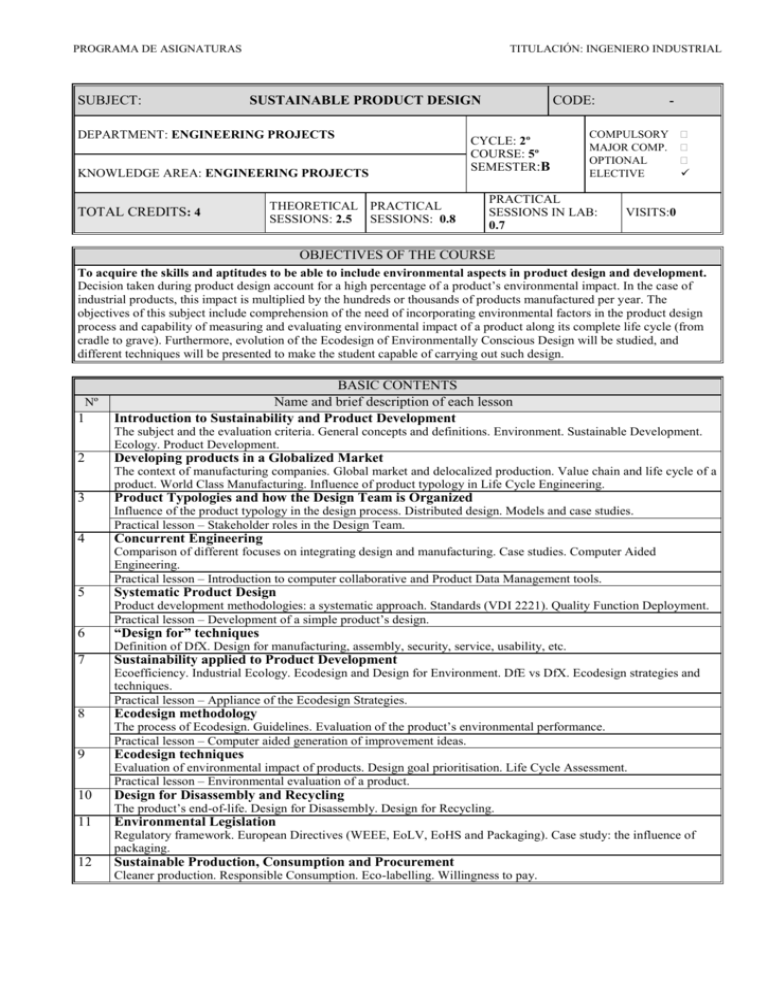
PROGRAMA DE ASIGNATURAS SUBJECT: TITULACIÓN: INGENIERO INDUSTRIAL SUSTAINABLE PRODUCT DESIGN DEPARTMENT: ENGINEERING PROJECTS KNOWLEDGE AREA: ENGINEERING PROJECTS TOTAL CREDITS: 4 CODE: CYCLE: 2º COURSE: 5º SEMESTER:B THEORETICAL PRACTICAL SESSIONS: 2.5 SESSIONS: 0.8 - COMPULSORY MAJOR COMP. OPTIONAL ELECTIVE PRACTICAL SESSIONS IN LAB: 0.7 VISITS:0 OBJECTIVES OF THE COURSE To acquire the skills and aptitudes to be able to include environmental aspects in product design and development. Decision taken during product design account for a high percentage of a product’s environmental impact. In the case of industrial products, this impact is multiplied by the hundreds or thousands of products manufactured per year. The objectives of this subject include comprehension of the need of incorporating environmental factors in the product design process and capability of measuring and evaluating environmental impact of a product along its complete life cycle (from cradle to grave). Furthermore, evolution of the Ecodesign of Environmentally Conscious Design will be studied, and different techniques will be presented to make the student capable of carrying out such design. Nº 1 BASIC CONTENTS Name and brief description of each lesson Introduction to Sustainability and Product Development The subject and the evaluation criteria. General concepts and definitions. Environment. Sustainable Development. Ecology. Product Development. 2 Developing products in a Globalized Market The context of manufacturing companies. Global market and delocalized production. Value chain and life cycle of a product. World Class Manufacturing. Influence of product typology in Life Cycle Engineering. 3 Product Typologies and how the Design Team is Organized Influence of the product typology in the design process. Distributed design. Models and case studies. Practical lesson – Stakeholder roles in the Design Team. 4 Concurrent Engineering Comparison of different focuses on integrating design and manufacturing. Case studies. Computer Aided Engineering. Practical lesson – Introduction to computer collaborative and Product Data Management tools. 5 Systematic Product Design Product development methodologies: a systematic approach. Standards (VDI 2221). Quality Function Deployment. Practical lesson – Development of a simple product’s design. 6 “Design for” techniques Definition of DfX. Design for manufacturing, assembly, security, service, usability, etc. 7 Sustainability applied to Product Development Ecoefficiency. Industrial Ecology. Ecodesign and Design for Environment. DfE vs DfX. Ecodesign strategies and techniques. Practical lesson – Appliance of the Ecodesign Strategies. 8 Ecodesign methodology 9 Ecodesign techniques The process of Ecodesign. Guidelines. Evaluation of the product’s environmental performance. Practical lesson – Computer aided generation of improvement ideas. Evaluation of environmental impact of products. Design goal prioritisation. Life Cycle Assessment. Practical lesson – Environmental evaluation of a product. 10 Design for Disassembly and Recycling 11 Environmental Legislation The product’s end-of-life. Design for Disassembly. Design for Recycling. Regulatory framework. European Directives (WEEE, EoLV, EoHS and Packaging). Case study: the influence of packaging. 12 Sustainable Production, Consumption and Procurement Cleaner production. Responsible Consumption. Eco-labelling. Willingness to pay. PROGRAMA DE ASIGNATURAS TITULACIÓN: INGENIERO INDUSTRIAL BASIC REFERENCES EcoDesign: a promising approach to sustainable production and consumption. J.C. Brezet and C.G. van Hemel, UNEP, Paris - 1997 A Concurrent Engineering Methodology for the Design of Robust Manufacturing Systems. P.C. Benjamin and R.J. Mayer. Proceedings of Autofact'91 Conference, Chicago, 1991, pp 27.37-27.53. Design for Assembly. G. Boothroyd and P. Dewhurst. Univ. Massachusetts, Amhurst, USA, 1983 Total Quality Development (World-Class Concurrent Engineering). D. Clausing, ASME Press, New York, 1994 Engineering Design Methods (Strategies for Product Design), 2ª ed. N. Cross. John Wiley & Sons, Chichester, 1994 Theory of Technical Systems. V. Hubka and W.E. Eder. Springler-Verlag, Berlin, 1988 Engineering Design. A Systematic Approach. G. Pahl and W. Beitz. Springer-Verlag, London, 1996 Total Design (Integrated methods for successful product engineering). S. Pugh. Addison-Wesley, Workingham, 1991 Product Design: Fundamentals and Methods. N.F.M. Roozemburg and J. Eekels. Wiley, Chichester, 1995 Concurrent Engineering. G. Sohlenius. Anals of CIRP. 41/2.1992. The Principles of Design. N.P. Suh. Oxford University Press, New York, 1990 The Mechanical Design Process. D. Ullman. McGraw-Hill, New York, 1992 Systematic Approach to the Design of Technical Systems and Products (VDI 2221). VDI (Verein Deustcher Ingenieure). VDI-Gesellschaft Entwicklung Konstruktion Vertrieb, Berlin, 1987 Sustainable Solutions. M. Charter and U. Tischner. Greenleaf, Sheffield, 2001 Ingeniería de Diseño Medioambiental. DFE. J. Ficksel. McGraw-Hill, Madrid, 1996. Life Cycle Design Guidance Manual. G.A. Keolian, D. Menerey. EPA600/R-92/226., US Environmental Protection Agency, Office of Research and Dev., Washington DC, 1993 ISO 14040 Environmental management — Life cycle assessment — Principles and framework ISO 14044 Environmental management — Life cycle assessment — Requirements and guidelines VDI 2243: Konstruieren Recyclinggerechter Technischer Produkte (Diseño de Productos Técnicos para simplificar su reciclaje). VDI (Verein Deutscher Ingenieure) VDI-Gesellschaft Entwicklung Konstruktion Vertrieb, 1993 Ecodiseño: Ingeniería del ciclo de vida para el desarrollo de productos sostenibles. Ed, S.F. Capuz and T. Gómez, Servicio de Publicaciones UPV, Valencia -2002 Introducción al Proyecto de Producción, Ing. concurrente para el diseño de producto. S.F. Capuz, Servicio de Publicaciones UPV, Valencia -1999 STAFF RESPONSIBLE Salvador F. Capuz Rizo Daniel Collado Ruiz
